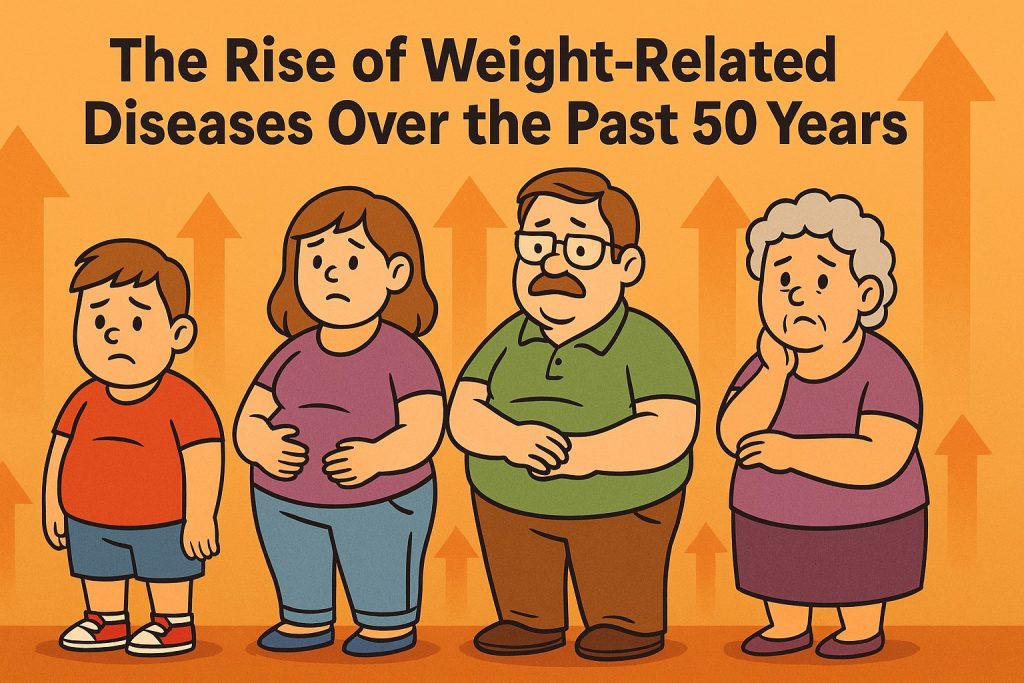Over the last five decades, the world has seen a dramatic surge in diseases linked to overweight and obesity. Once considered issues of high-income countries, these conditions are now widespread across the globe — from North America to Asia and sub-Saharan Africa. According to the World Health Organization, global obesity has nearly tripled since 1975, becoming one of the most pressing public health challenges of the modern era.
The causes are multifaceted. A global shift toward high-calorie, low-nutrient diets, coupled with increasingly sedentary lifestyles, has fundamentally altered human health patterns. Today, more people die from obesity-related illnesses than from undernutrition in many parts of the world.
Diseases on the Rise
Weight gain affects nearly every system in the body, and the list of associated health conditions is long. Among the most common are:
- Type 2 diabetes: Excess fat, especially around the abdomen, increases insulin resistance.
- Heart disease and stroke: Obesity raises blood pressure, cholesterol, and inflammation.
- Certain cancers: Including breast, colon, liver, kidney, and pancreatic cancers.
- Osteoarthritis: Extra weight puts strain on joints, especially knees and hips.
- Sleep apnea: Fat deposits around the upper airway lead to disrupted breathing during sleep.
- Fatty liver disease: Non-alcoholic fatty liver disease is now common in obese adults and even children.
These diseases not only reduce life expectancy but also lower quality of life and create significant healthcare costs for societies worldwide.
Children and Adolescents at Risk
Childhood obesity has increased at an alarming rate. In 1975, less than 1% of children aged 5–19 were obese. By 2020, that number had risen to over 8% of boys and 6% of girls globally, with much higher rates in some countries. These children are at greater risk of developing chronic diseases at a younger age and often struggle with mental health and social stigma.
Early intervention through healthy eating, physical activity, and education is critical to reverse this trend.
Urbanization and Lifestyle Changes
Modern lifestyles have shifted dramatically over the past 50 years. Urbanization has led to increased consumption of processed foods, reduced physical activity, and a reliance on cars instead of walking or cycling. Many people now work desk jobs, spend hours on screens, and have limited access to fresh produce or safe recreational areas.
At the same time, aggressive food marketing and the global spread of fast-food chains have normalized unhealthy eating habits, especially among younger generations.
Combating the Epidemic
Reversing the rise in weight-related diseases requires both personal and systemic changes. Individuals can improve their health through balanced nutrition, regular exercise, and avoiding ultra-processed foods. However, broader solutions include:
- Government regulations on unhealthy food marketing
- Urban planning that encourages physical activity
- Taxation of sugary drinks and junk food
- School programs promoting healthy habits
- Improved access to healthy, affordable food
Public awareness campaigns and strong health policies are essential to create supportive environments for healthier choices.
Glossary
- Obesity – A medical condition defined by excessive body fat that increases the risk of health problems.
- Insulin resistance – A condition in which cells respond poorly to insulin, often leading to type 2 diabetes.
- Non-alcoholic fatty liver disease – Liver fat buildup not caused by alcohol, often linked to obesity.
- Sedentary lifestyle – A type of lifestyle with little to no physical activity.
- Processed foods – Foods altered during manufacturing to extend shelf life, often high in sugar, salt, and fat.


